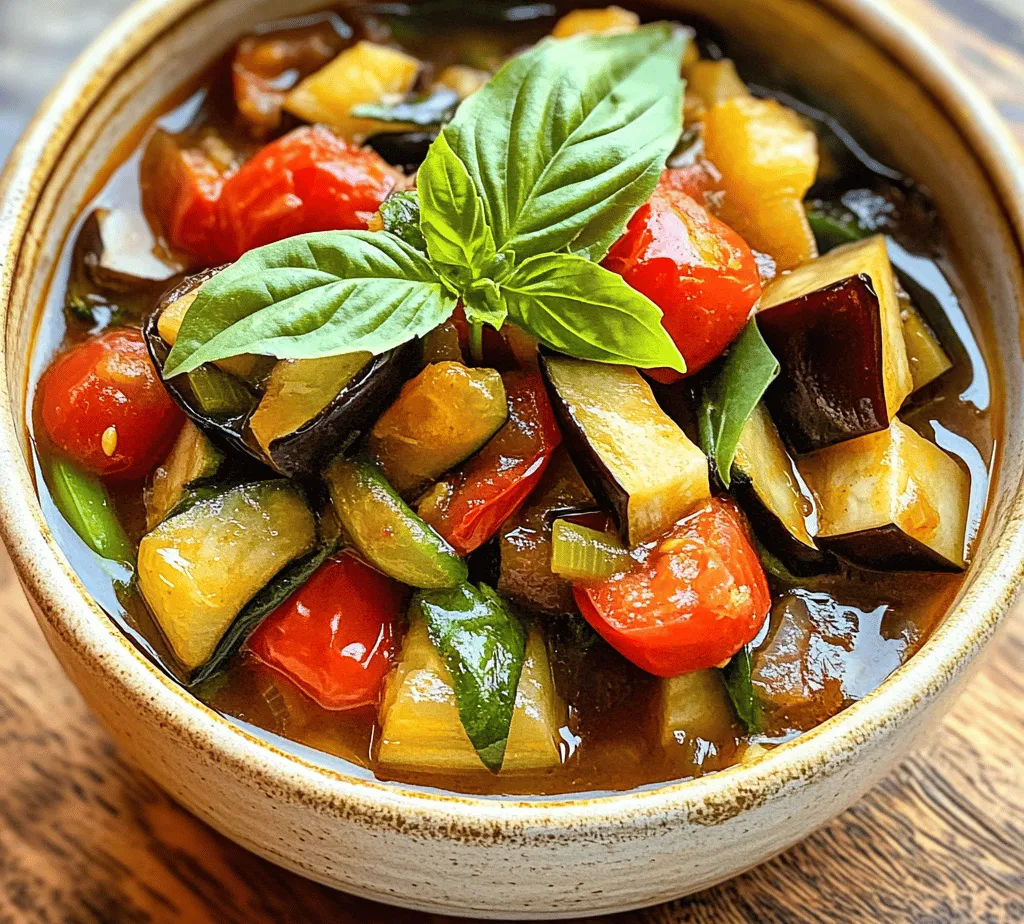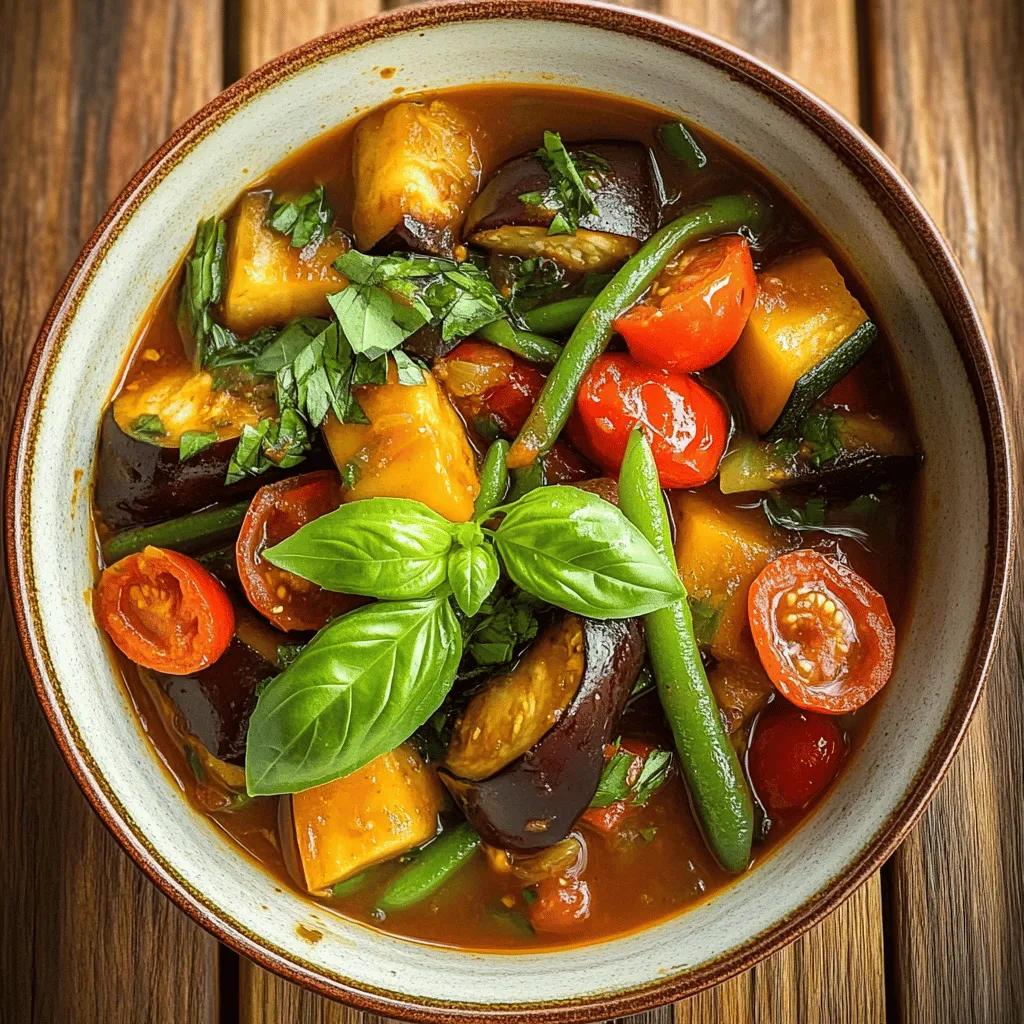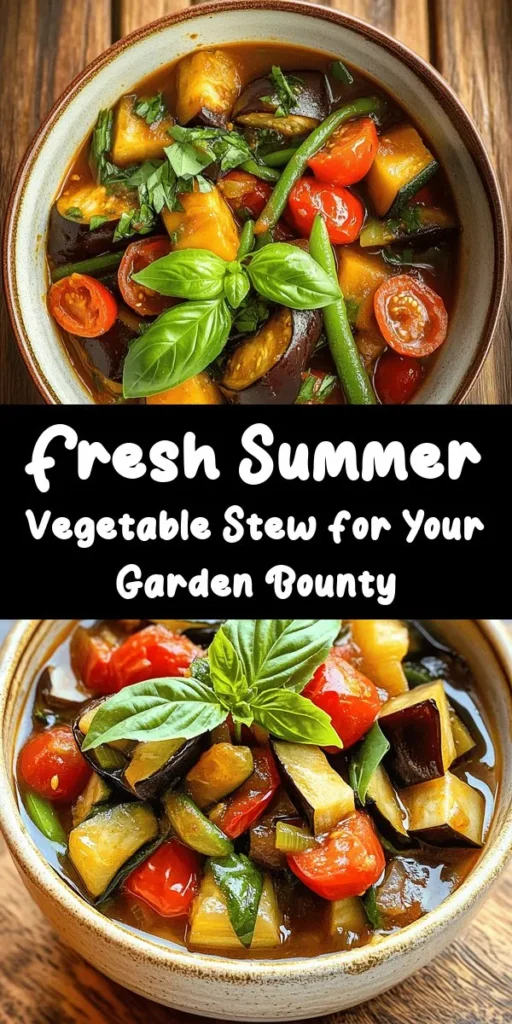As the sun shines brightly and gardens burst into life, summer cooking takes on a vibrant and refreshing character. One dish that perfectly encapsulates the essence of this season is the delightful summer vegetable stew. This wholesome recipe celebrates the best of what summer has to offer, combining a variety of fresh, colorful vegetables with aromatic herbs and spices. Not only is it a satisfying meal, but it is also a joyous celebration of nature’s bounty, making it an excellent choice for family dinners or meal prepping. The versatility of this stew allows it to be easily adapted to suit diverse dietary preferences, whether you are a committed vegetarian, a health-conscious eater, or simply looking for a delicious way to incorporate more vegetables into your diet.
The Health Benefits of a Vegetable-Forward Diet
Incorporating more vegetables into your meals can significantly enhance your overall health and well-being. A vegetable-forward diet is linked to numerous health benefits, including improved weight management, enhanced energy levels, and a lower risk of chronic diseases. By loading up on fresh, seasonal produce, you are not only nourishing your body but also supporting local farmers and reducing your carbon footprint.
The specific ingredients in this summer vegetable stew are particularly beneficial for your health. Let’s take a closer look at some of the star ingredients:
– Eggplant: This versatile vegetable is rich in antioxidants and dietary fiber, making it a fantastic addition to your diet. Antioxidants help combat oxidative stress, while fiber aids in digestion and promotes a feeling of fullness.
– Zucchini: Low in calories and high in water content, zucchini is a great option for those looking to manage their weight. Additionally, it provides a good source of vitamin C, which is essential for a healthy immune system.
– Bell Peppers: Available in a variety of colors, bell peppers are high in vitamin A and C, both of which are beneficial for skin and eye health. Their sweet, crisp texture adds a delightful crunch to the stew.
– Tomatoes: Packed with lycopene, tomatoes are known for their heart health benefits. Lycopene is a powerful antioxidant that can help reduce the risk of heart disease and certain types of cancer.
– Green Beans: These crunchy legumes are not only tasty but also a great source of vitamins A, C, and K. Green beans add a lovely green hue to the stew, enhancing both its visual appeal and nutritional profile.
By choosing to fill your plate with colorful vegetables, you are giving your body a wide array of vitamins, minerals, and antioxidants that promote better health and vitality. Embracing a vegetable-forward diet, especially during the summer months when produce is at its peak freshness, can lead to delicious and nourishing meals.
Ingredient Breakdown: Preparing for Your Stew
Before diving into the cooking process, it’s essential to gather all the necessary ingredients for your summer vegetable stew. Here’s a detailed overview of what you’ll need:
Main Ingredients:
1. Eggplant: Look for firm, shiny eggplants with smooth skin. Avoid any that have soft spots or blemishes. When preparing the eggplant for the stew, cut it into bite-sized cubes. This will help it cook evenly and absorb the flavors of the stew.
2. Zucchini: Choose small to medium-sized zucchinis, which tend to be more tender and flavorful. Slice them into half-moons to ensure even cooking.
3. Bell Peppers: You can use any color of bell pepper—red, yellow, or green—based on your preference. Each variety has its unique flavor profile, with red being the sweetest. Remove the seeds and chop them into bite-sized pieces.
4. Tomatoes: Fresh, ripe tomatoes are ideal for this recipe. You can use Roma tomatoes for their dense flesh, or larger varieties for a juicier stew. Chop them into chunks, and if using canned tomatoes, opt for high-quality brands with minimal additives.
5. Green Beans: Fresh green beans should be bright green and firm. Trim the ends and cut them into 1-2 inch pieces for easy eating.
Additional Ingredients:
– Onion: A yellow or sweet onion will add depth and sweetness to your stew.
– Garlic: Fresh garlic cloves, minced, will enhance the overall flavor profile.
– Vegetable Broth: A good-quality vegetable broth serves as the base for your stew. Feel free to use homemade broth or store-bought.
– Herbs and Spices: Fresh herbs such as basil, thyme, or parsley will elevate your dish. Additionally, consider adding spices like paprika or cumin for a warm, aromatic touch.
Tips for Selecting Fresh Produce:
When shopping for ingredients, aim to visit your local farmers’ market or grocery store that prioritizes seasonal produce. Look for vibrant colors, firm textures, and avoid any signs of wilting or spoilage. Seasonal vegetables not only taste better but also offer maximal nutritional benefits.
Seasonal Variations and Substitutions:
While this recipe focuses on the quintessential summer vegetables, you can easily adapt it to reflect the changing seasons. For example, in the fall, consider adding root vegetables like carrots or sweet potatoes. In the winter, hearty greens such as kale or collard greens would work wonderfully. This adaptability allows you to enjoy a comforting vegetable stew year-round while using ingredients that are at their peak.
Essential Cooking Techniques for a Flavorful Stew
Preparing a flavorful vegetable stew is not only about the right ingredients but also about employing effective cooking techniques. Here are some essential methods to enhance the taste and texture of your summer vegetable stew:
Sautéing:
Sautéing is a fundamental technique that involves cooking food quickly in a small amount of oil over medium-high heat. This method helps to caramelize the natural sugars in vegetables, intensifying their flavors. Start by heating a tablespoon of olive oil in a large pot or Dutch oven. Add your chopped onions and garlic, sautéing until they become translucent and fragrant. This initial step lays the flavor foundation for your stew, allowing the other vegetables to shine.
Simmering:
Simmering is a crucial step that allows the flavors of your stew to meld together beautifully. After sautéing your base ingredients, add the remaining chopped vegetables and vegetable broth to the pot. Bring the mixture to a gentle boil, then reduce the heat to low, allowing it to simmer uncovered. This slow cooking process enables the vegetables to soften while infusing the broth with their natural flavors. Simmering will typically take around 20-30 minutes, depending on the size of your vegetable pieces and your desired level of doneness.
Garnishing:
The art of presentation should not be overlooked when it comes to serving your summer vegetable stew. Fresh herbs, such as basil or parsley, can be finely chopped and sprinkled on top just before serving. This not only adds a burst of color but also enhances the dish’s overall flavor profile. A drizzle of high-quality olive oil can also elevate the presentation and add a touch of richness.
By mastering these essential cooking techniques, you’ll create a flavorful and satisfying summer vegetable stew that showcases the best of seasonal produce. The combination of sautéing, simmering, and garnishing will ensure a dish that is not only delicious but also visually appealing, making it a delightful centerpiece for any summer meal.
As you prepare to dive into the cooking process, you’re now equipped with a wealth of knowledge about the health benefits, ingredient selection, and cooking techniques that will help you create a memorable summer vegetable stew. With each bite, you’ll savor the essence of summer while nourishing your body with wholesome ingredients.

Step-by-Step Guide to Making Summer Vegetable Stew
Creating an exquisite summer vegetable stew requires some care and attention to detail. By following this step-by-step guide, you’ll transform fresh seasonal produce into a delightful dish that highlights the flavors of summer.
Preparing Your Ingredients
Before you begin cooking, it is essential to prepare your ingredients. This process, known as mise en place, involves gathering and prepping all your ingredients before you start cooking. This practice not only streamlines the cooking process but also ensures you don’t forget any essential components.
– Chop Your Vegetables: Aim for uniform sizes to ensure even cooking. For this stew, you’ll want to dice your onions, carrots, and zucchini into bite-sized pieces. Slice bell peppers into strips and chop any leafy greens you plan to add, such as kale or spinach.
– Measure Your Seasonings: Have your herbs, spices, and any necessary liquids ready to go. This includes your vegetable broth, olive oil, salt, and pepper.
– Gather Cooking Tools: Ensure you have a large pot, wooden spoon, cutting board, and knife at hand. Having everything ready makes for a smoother cooking experience.
Sautéing the Aromatics
With your ingredients prepared, it’s time to build the flavor base of your stew. Heat a generous splash of olive oil in a large pot over medium heat.
– Add Aromatics: Begin by adding diced onions and minced garlic to the pot. Sauté these for about 3-5 minutes until the onions become translucent and aromatic. This step is crucial as it lays the foundation for the stew’s flavor profile.
– Introduce Other Aromatics: If using herbs like thyme or rosemary, add them at this stage to allow their flavors to infuse into the oil.
Cooking the Vegetables
Once your aromatics are fragrant, it’s time to add the vegetables. The order in which you add them is essential for achieving the ideal texture.
– Start with Root Vegetables: Begin by adding the diced carrots and any other root vegetables you are using. Sauté these for about 5 minutes until they start to soften.
– Add Bell Peppers and Zucchini: Next, introduce the bell peppers and zucchini. These vegetables cook quicker than carrots and contribute a fresh, tender bite to the stew. Sauté for another 5 minutes, stirring occasionally.
– Incorporate Leafy Greens: If you’re using greens like kale or spinach, add them towards the end of this step. They require minimal cooking time and will wilt nicely into the stewed mixture.
Simmering to Perfection
Now that your vegetables are in the pot, it’s time to add liquid and let everything simmer.
– Add Broth: Pour in your vegetable broth, ensuring it covers the vegetables. If you prefer a thicker stew, you can use less broth.
– Bring to a Boil: Increase the heat to high until the mixture comes to a boil, then reduce to a gentle simmer.
– Simmer Time: Allow the stew to simmer for about 20-30 minutes. During this time, the flavors will meld together beautifully. Taste the stew halfway through and adjust seasoning as needed, adding salt and pepper to enhance the flavors.
Serving Suggestions
Your summer vegetable stew is now ready to serve! Here are some delightful serving suggestions to enhance your meal:
– Crusty Bread: Serve the stew with slices of freshly baked crusty bread. It’s perfect for soaking up the delicious broth.
– Side Salad: A light green salad dressed with a simple vinaigrette complements the stew well and adds a refreshing crunch.
– Herb Garnish: Consider garnishing with fresh herbs such as basil or parsley for a burst of color and additional flavor.
Tips for Customizing Your Vegetable Stew
Encourage your creativity in the kitchen by personalizing your summer vegetable stew. Here are some tips to make the dish uniquely yours:
Ingredient Substitutions
If you have dietary restrictions or simply want to use what you have on hand, consider these substitutions:
– Vegetable Varieties: Swap out zucchini for yellow squash or use different varieties of bell peppers for a change in taste.
– Protein Additions: For a heartier stew, add cooked beans, lentils, or chickpeas. These will not only provide protein but also enhance the stew’s texture.
Flavor Enhancements
To elevate the flavor profile of your stew, consider the following enhancements:
– Spices: Add a pinch of cumin or smoked paprika for a unique twist. These spices will deepen the overall flavor.
– Acidity: A splash of lemon juice or a tablespoon of vinegar can brighten the dish and enhance the natural flavors of the vegetables.
Serving Variations
The versatility of this stew allows for different serving options:
– Over Grains: Serve the stew over a bed of rice, quinoa, or couscous for a more filling meal. This also adds an interesting texture.
– Standalone Dish: Enjoy the stew on its own as a light, nutritious meal, especially during warm summer evenings.
The Versatility of Summer Vegetable Stew: Meal Prep and Storage
One of the best aspects of summer vegetable stew is its practicality for meal prepping and storage. Here’s how to make the most of your stew:
Meal Prepping
Making a large batch of stew can save time throughout the week.
– Batch Cooking: Prepare a big pot of stew and portion it out into containers. This way, you have ready-to-eat meals for busy days or quick lunches.
– Mix-and-Match Meals: Use the stew as a base for different meals. Pair it with various sides each day to keep your meals interesting.
Freezing
If you want to store your stew for longer, freezing is an excellent option.
– Freezing Guidelines: Allow the stew to cool completely before transferring it to airtight containers or freezer bags. Portioning it into single servings makes thawing easier.
– Flavor Preservation: To maintain the flavors, try to consume frozen stew within three months for the best taste.
Reheating Tips
When it’s time to enjoy your frozen stew, proper reheating is crucial to preserving its quality.
– Stovetop Reheating: For the best results, reheat the stew on the stovetop over medium heat. Stir occasionally until heated through. You may need to add a splash of broth or water to loosen it up.
– Microwave: If you’re in a hurry, you can use the microwave. Heat in short intervals, stirring in between, until hot.
Conclusion: Embracing Seasonal Cooking with Summer Vegetable Stew
Summer vegetable stew is not only a celebration of seasonal produce but also a heartwarming dish that brings comfort and nourishment to the table. This recipe embodies the vibrant flavors of summer, showcasing a variety of fresh vegetables that are both delicious and nutritious.
By embracing the art of seasonal cooking, you can enjoy the bounty of the season while fostering a love for healthy eating. Don’t hesitate to experiment with different ingredients, spices, and serving methods to make this stew your own. The joy of cooking lies in creativity, so let your culinary imagination flourish as you explore the endless possibilities of summer vegetable stew.



